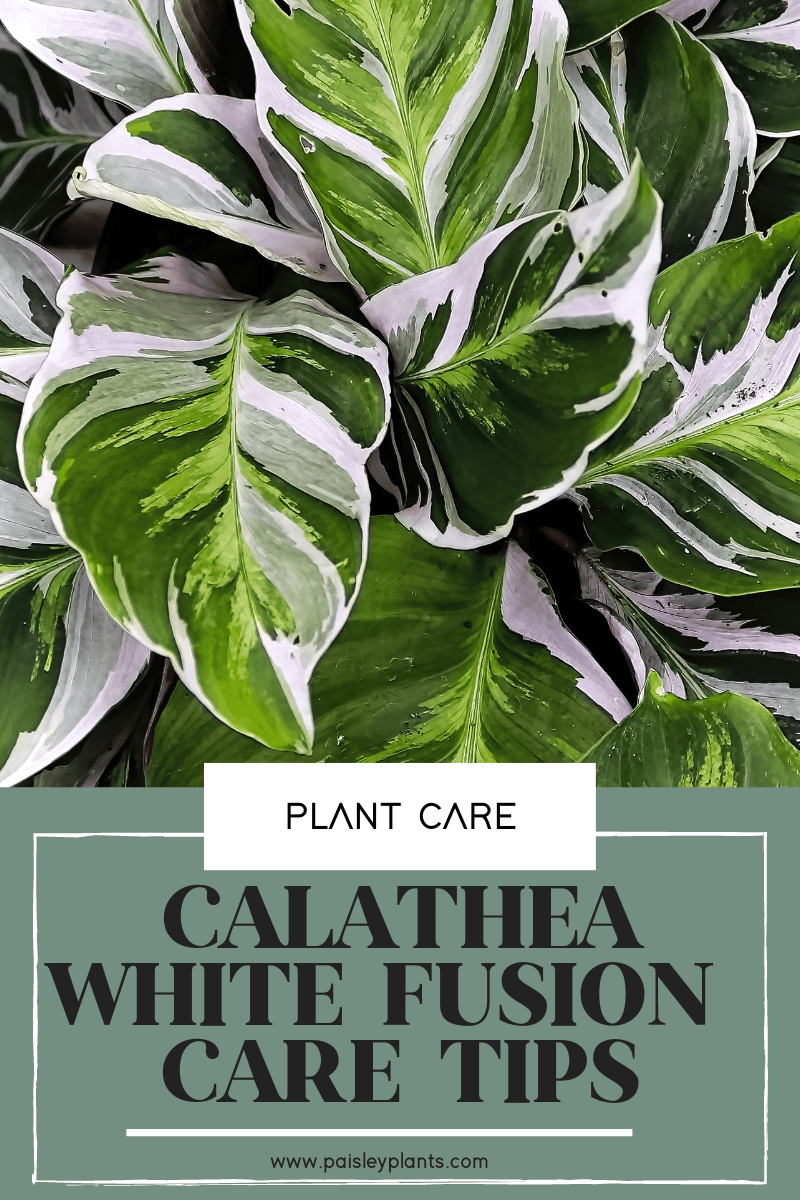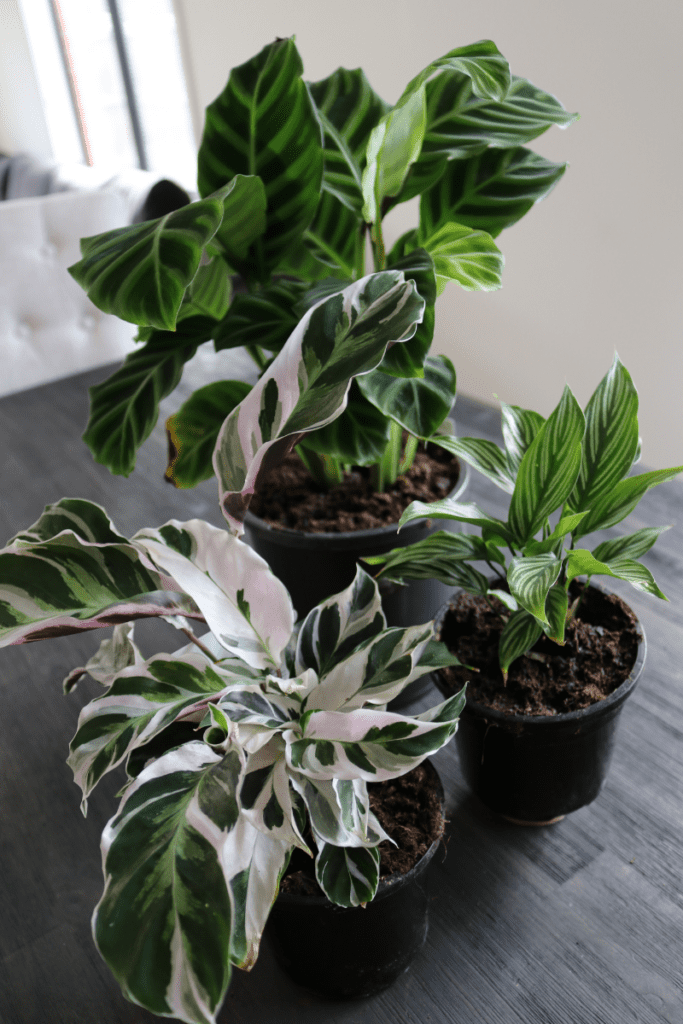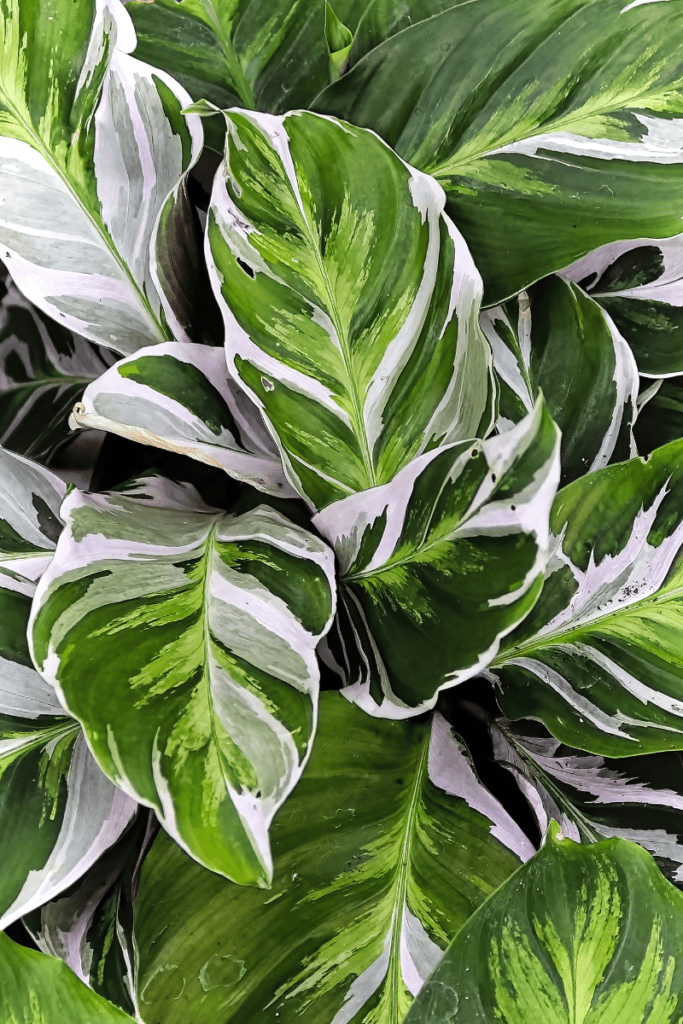The striking variegation of the Calathea White Fusion makes for a beautiful, eye-catching houseplant. You’ll be surprised by how easy this plant is to take care of. Read on to learn more about the Calathea White Fusion in this ultimate care guide.

This post includes affiliate links.
Table of Contents
Background
Native to Central America, the Calathea lietzei ‘White Fusion’ is a fascinating perennial tropical houseplant that is sure to turn heads. Common names for this plant include the peacock, zebra, or rattlesnake plant.
The Calathea White Fusion is recognizable for its interesting variegation. The green White Fusion leaves are marked with pink and white variegation all over them, making this plant very sought-after for houseplant collectors. This is a medium-sized houseplant, with mature specimens reaching a height of 2 feet tall.
Not only does its beautiful looks make it a great houseplant, but it is also non-toxic and pet-friendly. You can feel secure having this plant in your home with your furry friends.
Calathea White Fusion Care
Let’s chat Calathea White Fusion Care tips! This guide will help you grow and care for your plants with ease.
Sun & Light
Finding the perfect amount of light is very important for your calathea plants, as insufficient light can cause the white variegation to disappear from your plant. Your plant should have bright, filtered light. Try to aim to give your plants at least 6 hours of light a day.
If having enough light is hard, you can always use plant grow lights to give your plant adequate light.
Soil Type
The ideal soil type for a calathea plant is one that is acidic, well draining, yet can still retain moisture. Many plant owners opt to use a potting mix that is tailored towards African violets, as this has the same properties as a calathea potting mix. Alternatively, you can also mix your own soil by combining equal parts of orchid bark, perlite, and standard soil.
Water
The calathea prefers to have a soil that is consistently moist, though it is extremely important for plant owners to keep a sharp eye on how much water they give their plant. It is common for plant owners to accidentally give their calathea plants too much water.
To prevent overwatering, I highly recommend waiting until the first inch of water has dried up before you water your plant.
My best tip to not over or under water your plants is to do the finger test! Stick your finger a few inches into the soil of your plant. If it’s wet and soil sticks to your finger, don’t water it.
On the other hand, if the soil is dry and doesn’t stick to your finger it’s time to give it some water!

Fertilizer
Your plant will greatly appreciate a fertilizer routine throughout its growing period. During the spring, summer, and fall, apply a nitrogen-rich fertilizer to your houseplant. This fertilizer should only be applied once every month for the active growing season; completely cease fertilization during the winter.
White Fusion Humidity & Temperature
Luckily for home owners, the Calathea White Fusion is very tolerant of normal household temperatures. Ideally, your plant should be in a range of 60° to 77° F. Do not allow the temperature to dip below 60°, avoiding locations such as air conditioning vents or drafty windows.
Humidity levels are an important part when you care for the White Fusion Calathea. The White Fusion prefers higher levels of humidity, reaching a percentage of 75%. To increase the humidity level in your home, placing an electric humidifier in the same room as your plants is a great idea.
If the humidity leaves are too low, the leaves of your plants can dry up and get crispy quickly. If you don’t have a humidifier you could use keep your plants that need a higher humidity level under a glass dome terrarium. This will keep your humidity levels high and your plants happy!
Calathea Pruning & Maintenance
You should prune your calathea as you see fit. Occasionally, you may come across a leaf or leaves that appears to be dead or damaged, this should be dealt with immediately. Use a pair of clean, sharp pruning shears and cut off any leaves that need to be removed.
Choosing a Container & Repotting Calatheas
When selecting pots to grow your calathea in, it is important to select a pot that has good drainage. As we’ve discussed previously, calatheas love to live in a consistently moist soil.
Plants that enjoy a moist soil often run the risk of having too much moisture trapped in their containers, which can lead to fungal infections. By having drainage holes, excess moisture can be expelled from the bottom, which keeps your plant comfortably moist.
Calathea plants do not enjoy being root-bound, as this can open your plant up to possible fungal infections. Aim to repot your calathea once every 1 to 2 years. When repotting your plant, size up your new planter very gradually, only selecting pots the next size up.
Calathea White Fusion Propagation Tips

Calathea White Fusions can be propagated by using leaf cuttings. Follow these easy steps to make a new beautiful calathea plant.
White Fusion Propagation Steps:
- Prepare a small pot filled with lightly moistened potting soil.
- Cut a piece of stem off from the plant; cut about an inch below the node. This cutting should be entirely healthy, and contain a few leaves intact.
- Place the cut-end of the stem in the potting soil; make sure the leaves are above ground to allow for air circulation.
- Keep the potting soil lightly moist and place in a location that receives bright, but indirect light.
- Within a few weeks, the cutting should grow roots and establish itself. At this point, you may repot the cutting into a larger planter.
You can also propagate your Calathea plants using water propagation! Here’s you you would do that.
- Fill a jar or propagation station with water.
- Similar to above cut a piece of stem off from the plant; cut about an inch below the node. This cutting should be entirely healthy, and contain a few leaves intact.
- Place the cut-end of the stem in water; make sure the leaves are above ground to allow for air circulation. Remove any leaves that dip below the water.
- Switch out the water every week or so to prevent bacteria from growing. Place it in a location that receives bright, but indirect light.
- Within a few weeks, it will begin to grow roots in the water. After the roots grow to be a few inches long, you can plant them in soil.
Common Pests
Like with many plants that prefer a humid environment, you are unfortunately likely to run into fungus gnats when caring for calathea plants. Fungus gnats are tiny flying insects that infest potting mix. The gnat larvae like to feast on organic matter in soil, though they can also eat the roots of the plant. If these larvae are left untreated, they will eventually mature into adult fungus gnats that fly around your home.
While fungus gnats are a total nuisance in your home, they can be easily treated with natural, yet effective solutions. Since fungus gnats spend a majority of their life in their larva stage, early action is key. Spraying your soil with neem oil is a powerful, natural pest deterrent. If your fungus gnats have reached maturity and are flying around your plants, then they can easily be trapped by laying out yellow sticky tape
Common Diseases
Like with many houseplants, the White Fusion is susceptible to fungal diseases that are brought on due to overwatering. Over time, excess water gets trapped within the soil and causes the roots to break down. Signs of root rot include dying foliage that turns yellow.
While root rot is deadly, it can be remedied with intensive care. If you suspect your plant has it, follow these steps:
- Remove your plant from its pot and gently shake away excess dirt.
- Check the roots; rotted roots are mushy and black compared to the firm, off-white color of healthy roots.
- Take a sterile pair of scissors and cut off any rotted roots you see.
- Repot your plant using clean, new soil in a pot that has drainage holes
The best way to treat root rot in these plants is to prevent it from ever happening in the first place. Always make sure you are properly watering your plants, making sure that the soil is not overloaded with water.
A good rule of thumb with the calathea is to wait until the first inch of soil has dried up before you water your plants. In addition, it is always extremely important to select a planter that has drainage holes at the bottom.
Where to Buy
You can purchase these plants at one of places below!
FAQ
Yes, the Calathea Fusion White is considered to be a rare species of calathea. Like with many other plants with variegated leaves, it is very difficult to find these in the wild.
Propagating variegated plants does not always guarantee that the newly spawned plant will also have variegated leaves as well.
No, this Calathea plant isn’t hard to care for! I would argue that the most difficult part of caring for a White Fusion Calathea is maintaining the correct amount of lighting. As we now know the signature variegation of the leaves this plant is dependent on the amount of light. However, once you’ve found a perfect balance for this plant, then caring for it is a breeze.
Occasionally, you might notice dust build-up on the leaves of your plant. This can prevent your plant from getting enough air, as plants “breathe” through their leaves. Take a dry microfiber cloth and gently wipe the dust from your leaves. Do not use any chemical product marketed to clean leaves; it is simply unnecessary.
In Conclusion
As you can see, the Calathea White Fusion has some discerning preferences, but caring for this plant is very straightforward. With proper lighting, moisture, and air conditions, you too can grow a beautiful, thriving calathea.
Be sure to bookmark and save this guide to reference when you get your new plant!
Want more plant fun? Head to one of these plant care guides!

